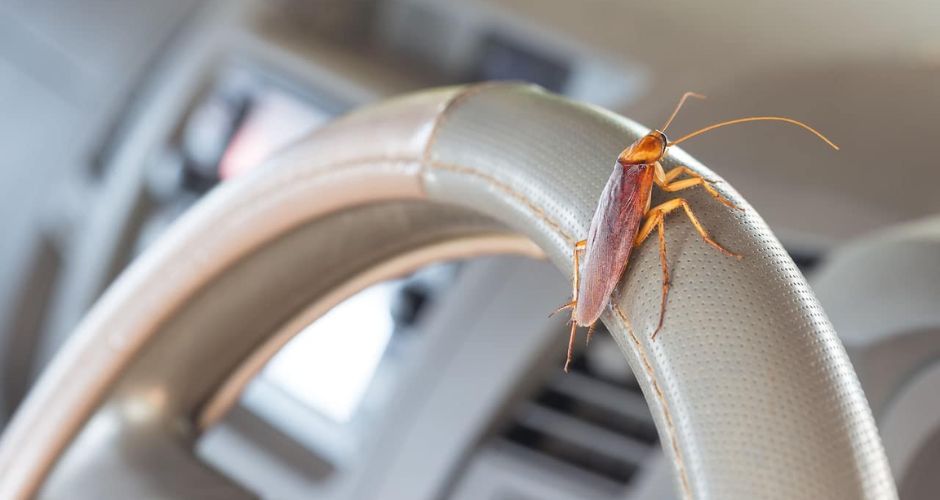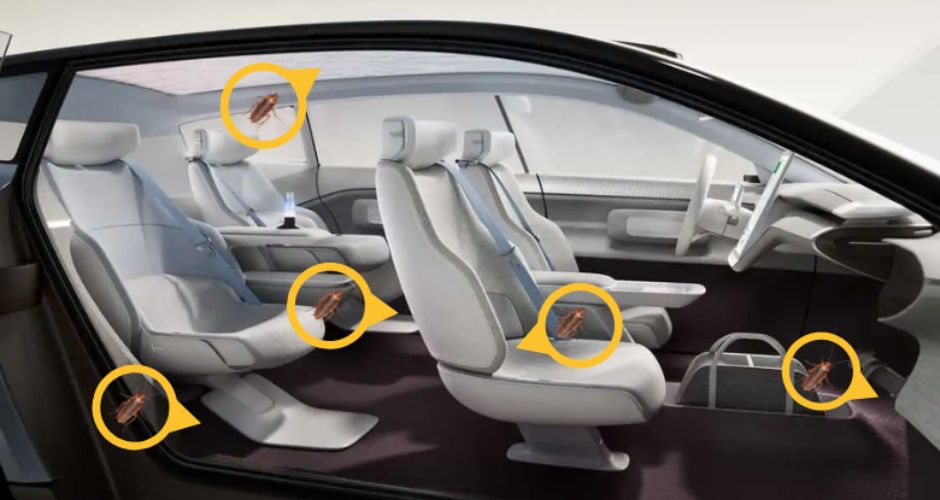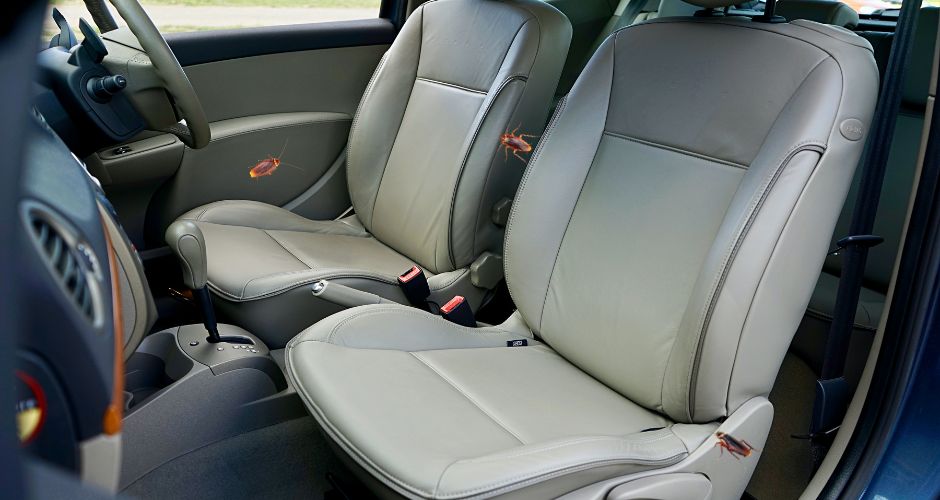How to Get Rid of Roaches in Car?

Many of us assume that roaches are confined to our homes but can also reside in our cars. Surprisingly, nearly every vehicle without a thorough cleaning for over three months is at risk of roach infestation. Even more concerning is that these unwanted guests could lurk inside your car without your knowledge.
In this post, we’ll delve into the ways how to get roaches out of car and essential precautionary measures to prevent their return. Are you curious about the unsettling relationship between roaches and our cars? Stick around till the end of this post.
Why do cockroaches prefer to live in cars?
Roaches are attracted to cars for several reasons, making them a common nuisance for vehicle owners. Here are some factors that contribute to why roaches prefer to live in vehicles:
- Food Sources: Cars often provide ample food sources for roaches. Crumbs, food spills, and leftover snacks can accumulate in the interior, providing an enticing feast for roaches.
- Warmth and Shelter: Cars offer a warm and sheltered environment that roaches find appealing, especially during colder months. The interior of a car protects from harsh weather conditions and predators, making it an ideal hiding spot for roaches.
- Moisture: Roaches are attracted to moisture-rich environments, and cars can provide the perfect conditions for them to thrive. Condensation from air conditioning systems or leaks in the vehicle can create humid areas that roaches are drawn to.
- Clutter: Cluttered cars with items stored in the trunk, glove compartment, or backseat offer plenty of hiding spots for roaches. Piles of newspapers, clothing, or cardboard boxes can provide ideal harborage areas for insects to nest and reproduce.
- Accessibility: Roaches can easily access cars through small openings or cracks in windows, doors, or vents. Once inside, they can quickly establish a presence and reproduce rapidly, leading to a full-blown infestation if left unchecked.
How do cockroaches get in our car?
Roaches can enter cars through various entry points, taking advantage of small openings or cracks in windows, doors, or vents. Here are some common ways roaches get into cars:
- Open Windows or Doors: Roaches can easily crawl into a car through open windows, doors, or sunroofs, especially if the vehicle is parked where roaches are present.
- Gaps and Cracks: Even tiny gaps or cracks in the car’s exterior, such as around windows, doors, or the trunk, can serve as entry points for roaches. They can squeeze through these openings and access the vehicle’s interior.
- Vents and Ducts: Roaches may enter cars through ventilation systems or air ducts. They can crawl through vents on the vehicle’s exterior or access the interior through ducts connected to the ventilation system.
- Hitchhiking: Roaches can hitch a ride into cars on items brought into the vehicle, such as bags, clothing, or boxes, especially if these items have been in contact with infested areas or objects.
- Infested Items: If items stored in the car, such as groceries or belongings, are infested with roaches, the insects may spread to other areas of the vehicle, including the interior.
Places Where Cockroaches Hide in Your Car
Cockroaches are notorious for their ability to hide in small, dark spaces, and cars provide plenty of hiding spots for these resilient pests. Here are some common places where cockroaches may hide in your car:
- Under the Seats: Cockroaches often seek shelter beneath the seats of a car, where they can find protection from light and access to food crumbs that may have fallen between or under the seats.
- Within Seat Cushions: The upholstery and padding of car seats provide cozy hiding spots for cockroaches. They may burrow into the cushions or hide within the folds of fabric.
- Dashboard: The dashboard of a car offers numerous crevices and compartments where cockroaches can hide. They may conceal themselves behind the dashboard, within air vents, or in storage compartments.

- Glove Compartment: Cockroaches may find their way into the glove compartment of a car, where they can hide among papers, documents, or other items stored inside.
- Door Panels: The interior panels of car doors often contain gaps or openings where cockroaches can enter and hide. They may seek refuge within the door panels, particularly if the car is parked in a dark or secluded area.
- Trunk: Cockroaches may also inhabit the trunk of a car, especially if it contains clutter or stored items that provide hiding places. They may hide beneath the trunk lining or within luggage or bags stored in the trunk.
- Engine Compartment: While less common, cockroaches may venture into the engine compartment of a car in search of warmth or shelter. They may hide near the engine block or in other protected areas within the compartment.
- Floor Mats and Carpeting: Floor mats and carpeting provide additional hiding spots for cockroaches, especially if they are soiled with food crumbs or spills. Cockroaches may burrow into the carpet fibers or hide beneath floor mats.
Can roaches in your car be dangerous?
While roaches in your car are primarily a nuisance, they can pose some potential risks and dangers:
- Allergies and Asthma: Cockroach droppings, shed skins, and saliva contain proteins that can trigger allergic reactions and exacerbate asthma symptoms in sensitive individuals.
- Disease Transmission: Cockroaches can carry and transmit various pathogens, including bacteria, viruses, and parasites, which may contaminate surfaces in your car and potentially cause illness if you come into contact with them.
- Damage to Property: Cockroaches may gnaw on and damage upholstery, fabric, wiring, and other materials in your car, leading to costly repairs or replacements.
- Unpleasant Odors: Cockroaches produce pheromones that can contribute to foul odors in your car, particularly if there is a large infestation.
- Distraction and Anxiety: Cockroaches in your car can be distracting and unsettling, potentially affecting your concentration and causing anxiety, especially if you have a phobia of cockroaches.
How do you tell if your car is infested with Cockroaches or not?
Identifying a cockroach infestation in your car may require some detective work, but there are several signs you can look out for:
- Sightings: Seeing live cockroaches scurrying around your car is the most obvious indication of an infestation. Cockroaches are nocturnal, so you may spot them hiding in dark, secluded areas during the day.
- Droppings: Cockroach feces resemble small, dark specks or pellets and may be found where roaches frequent, such as under seats, in the glove compartment, or near food crumbs.
- Odor: Cockroach infestations can produce a musty or oily odor, particularly in areas where roaches congregate or nest. If your car has a persistent, unpleasant smell that you can’t attribute to other sources, it could be a sign of roaches.
- Egg Casings: Cockroach egg cases, known as oothecae, are often deposited in hidden cracks and crevices. These cases are small, elongated, and brownish and may indicate an established infestation.
- Damage to Materials: Cockroaches may chew on and damage upholstery, fabric, paper, and other materials in your car. Look for signs of gnawing, frayed edges, or small holes that could indicate roach activity.
- Trails or Smears: Cockroaches produce secretions that leave behind trails or smears on surfaces as they move around your car. These trails may be visible on upholstery, dashboard surfaces, or door panels.
- Nesting Sites: Cockroaches prefer dark, warm, and moist environments for nesting. Check areas like the trunk, under seats, and storage compartments for signs of nesting materials, such as shredded paper, fabric, or insulation.

How to Get Rid of Roaches in Car?
To how to remove cockroaches from car, follow these steps:
- Thorough Cleaning: Start by removing all clutter and debris from your car, including trash, food crumbs, and any items that may attract roaches. Vacuum the interior thoroughly, paying special attention to cracks, crevices, and hidden areas where roaches may conceal.
- Sanitize Surfaces: Use a mild detergent or automotive interior cleaner to wipe down all surfaces inside your car, including upholstery, dashboard, door panels, and storage compartments. Sanitizing these areas will help remove food residues and eliminate roach attractants.
- Inspect for Hiding Places: Check areas where roaches are likely to hide, such as under seats, in the trunk, and around the engine compartment. Use a flashlight to illuminate dark corners and crevices where roaches may be lurking.
- Use Roach Baits or Traps: Place roach baits or traps strategically inside your car to lure and capture roaches. Choose products designed for vehicle use and follow the manufacturer’s instructions carefully.
- Apply Insecticide: Consider using a residual insecticide spray labeled for use in vehicles to treat infested areas. Apply the insecticide according to the product label, focusing on cracks, crevices, and entry points where roaches may enter your car.
- Seal Entry Points: Identify and seal any potential entry points where roaches may be gaining access to your car, such as gaps around doors, windows, or vents. Use silicone caulk or weather stripping to seal these openings and prevent roaches from entering.
- Monitor and Repeat Treatment: Keep an eye on your car for signs of roach activity and repeat the cleaning and treatment process as needed. Be persistent and thorough to eliminate all roaches and prevent future infestations.
- Seek Professional Help: If your efforts to remove roaches from your car are unsuccessful or the infestation is severe, consider contacting a pest control professional for assistance. They can provide expert advice and treatment options to eradicate roaches from your vehicle effectively.
DIY Tips To Remove Roaches From Your Car
Here are some DIY tips to help you how to get roaches out of your car:
- Deep Clean Your Car: Start by thoroughly cleaning your car’s interior. Remove all clutter, trash, and food crumbs, as these can attract roaches. Use a vacuum cleaner to clean the seats, carpets, and floor mats, paying close attention to cracks, crevices, and hidden areas where roaches may be concealed.
- Use Natural Repellents: Consider using natural roach repellents such as peppermint oil, bay leaves, or cedar chips. Place these repellents inside your car strategically to deter roaches from entering.
- Set Roach Traps: Place roach traps or homemade traps inside your car to capture roaches. You can make DIY traps using a small container filled with soapy water or a mixture of sugar and baking soda. Place these traps where roaches are likely to hide, such as under seats or in the trunk.
- Apply Diatomaceous Earth: Diatomaceous earth is a natural insecticide that can help kill roaches. Sprinkle diatomaceous earth around the perimeter of your car’s interior and in areas where roaches are active. Wear a mask and gloves when handling diatomaceous earth, as it can irritate the skin and respiratory system.
- Seal Entry Points: Inspect your car for any potential entry points where roaches may enter, such as gaps around doors, windows, or vents. Use silicone caulk or weather stripping to seal these openings and prevent roaches from entering.
- Keep Your Car Clean: To prevent future infestations, maintain good hygiene practices in your car. Avoid eating or drinking inside the car, and regularly clean and vacuum the interior to remove any food crumbs or spills.
- Use Essential Oils: Certain essential oils, such as lavender, eucalyptus, or tea tree oil, have natural insect-repellent properties. Dilute a few drops of essential oil in water and spray it inside your car to repel roaches.
- Regular Inspections: Perform routine car inspections to check for signs of roach activity. Look for droppings, egg casings, or live roaches, especially in dark, hidden areas.
Following these DIY tips and maintaining a clean and hygienic car can effectively remove roaches and prevent them from returning. If the infestation persists or worsens, consider seeking professional pest control assistance.
Related Articles






